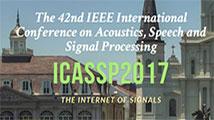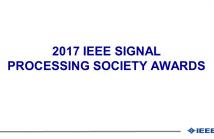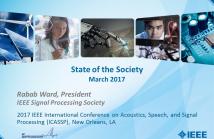
ICASSP is the world's largest and most comprehensive technical conference on signal processing and its applications. It provides a fantastic networking opportunity for like-minded professionals from around the world. ICASSP 2017 conference will feature world-class presentations by internationally renowned speakers and cutting-edge session topics. Visit ICASSP 2017
- Read more about CONFIDENCE MEASURES FOR CTC-BASED PHONE SYNCHRONOUS DECODING
- Log in to post comments
- Categories:
 41 Views
41 Views- Read more about Automatic Speech Emotion Recognition Using Recurrent Neural Networks with Local Attention
- Log in to post comments
Automatic emotion recognition from speech is a challenging task which relies heavily on the effectiveness of the speech features used for classification. In this work, we study the use of deep learning to automatically discover emotionally relevant features from speech. It is shown that using a deep recurrent neural network, we can learn both the short-time frame-level acoustic features that are emotionally relevant, as well as an appropriate temporal aggregation of those features into a compact utterance-level representation.
icassp2017.pdf
- Categories:
 195 Views
195 Views

- Categories:
 32 Views
32 Views- Read more about STATISTICS OF NATURAL FUSED IMAGE DISTORTIONS
- Log in to post comments
The capability to automatically evaluate the quality of long wave infrared (LWIR) and visible light images has the potential to play an important role in determining and controlling the quality of a resulting fused LWIR-visible image. Extensive work has been conducted on studying the statistics of natural LWIR and visible light images. Nonetheless, there has been little work done on analyzing the statistics of fused images and associated distortions.
- Categories:
 15 Views
15 Views- Read more about Pre-processing And Classification Of Hyperspectral Imagery Via Selective Inpainting Presentation
- Log in to post comments
We propose a semi-supervised algorithm for processing and classification of hyperspectral imagery. For initialization, we keep 20% of the data intact, and use Principal Component Analysis to discard voxels from noisier bands and pixels. Then, we use either an Accelerated Proximal Gradient algorithm (APGL), or a modified APGL algorithm with a penalty term for distance between inpainted pixels and endmembers (APGL Hyp), on the initialized datacube to inpaint the missing data. APGL and APGL Hyp are distinguished by performance on datasets with full pixels removed or extreme noise.
- Categories:
 44 Views
44 Views- Read more about STEGANOGRAPHY WITH TWO JPEGS OF THE SAME SCENE
- Log in to post comments
- Categories:
 3 Views
3 Views